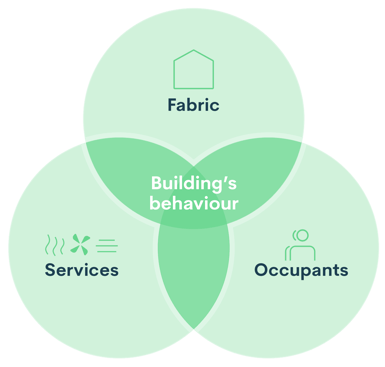
The newly drafted Part O of the UK building regulations, mandating measures to mitigate domestic overheating, will come into force in June 2022. Some homes can comply...
The Atamate building operating system (atBOS) was designed around the premise that mitigating overheating should be a priority for any building project. Its sensors can collect data to quantify overheating in an existing building and inform renovations as well as for post-occupancy evaluation on a new build or completed renovation.
At Atamate, we’ve been calling for measures to mitigate overheating to be written into the building regulation for some time. We’re gratified to see that the Department for Levelling Up, Housing and Communities (DLUHC) has now done so by drafting Part O of the UK building regulations which, as we’ve summarised elsewhere, comes into force in June 2022.
The atBOS functions that can be applied to mitigating overheating fall into two broad categories:
This article will discuss the role of data collection while a companion article describes how placing a building’s services under atBOS control can address an overheating problem.
Our view is that the first step in any renovation project is to fully understand the building as a dynamic entity in which its fabric, services and occupants interact to drive its behaviour. As described in detail in our white paper [PDF] on renovating a building to cut its carbon emissions, installing a sensor network captures data that can be used to build a detailed understanding of that behaviour. That model can then be used to plan renovations in a way that ensures the costs and increase in a building’s embodied carbon are paid back by savings in bills and operational carbon.
 |
| The building as a dynamic entity |
Such an approach is both informed by and compliant with the TM59 methodology, published by the Chartered Institute of Building Service Engineers (CIBSE) underpinning Part O’s dynamic thermal modelling method. Sensors continuously monitor the internal environment, including the temperature, enabling a designer to identify, evaluate and plan the best way to mitigate an overheating problem. For example, if a room overheats when it receives direct sunlight, solar gains can be mitigated by external shading but if the overheating problem can be traced to hot water pipework, the solution may be to improve the pipe’s insulation or temperature control may only be possible using mechanical ventilation or air conditioning.
Among the parameters that atBOS records, room occupancy is critical because the TM59 definition of unacceptable overheating is based on how much time a room spends over a threshold temperature while it is occupied. A model based on atBOS sensor data includes a precise record of how often each room is occupied for, avoiding spending money that would only mitigate overheating in unoccupied rooms.
The atBOS sensor network collects and stores continuous data on the indoor environment which can either confirm that a building is compliant with the Part O regulations or that it is not, in which case it can inform the renovations needed to address its overheating problem.
Because atBOS records both the indoor temperature and whether a room is occupied, its data can be used to assess the TM59 definition of overheating which is based on a room’s temperature during occupied hours only. Without direct measurement of occupancy, the designated building control body may require the assumption that rooms are occupied for much longer than they actually are, which may lead to a requirement to over-ventilate those rooms or to install larger and more energy-hungry aircon units than are needed.
Data collected by atBOS can identify the most cost-efficient and effective way to comply with Part O during a renovation and it can also be used for post-occupancy evaluation to confirm that overheating has indeed been mitigated. The next article will describe how atBOS can control building services to keep a building comfortable with the minimum energy expenditure.
If you’d like to know more about how Atamate can help to mitigate overheating in buildings, ask us on the form and we'll be happy to discuss it.

The newly drafted Part O of the UK building regulations, mandating measures to mitigate domestic overheating, will come into force in June 2022. Some homes can comply...

Atamate's smart building controls use the technology of the internet of things to keep a building safe and secure and to simplify the management of multi-use buildings....